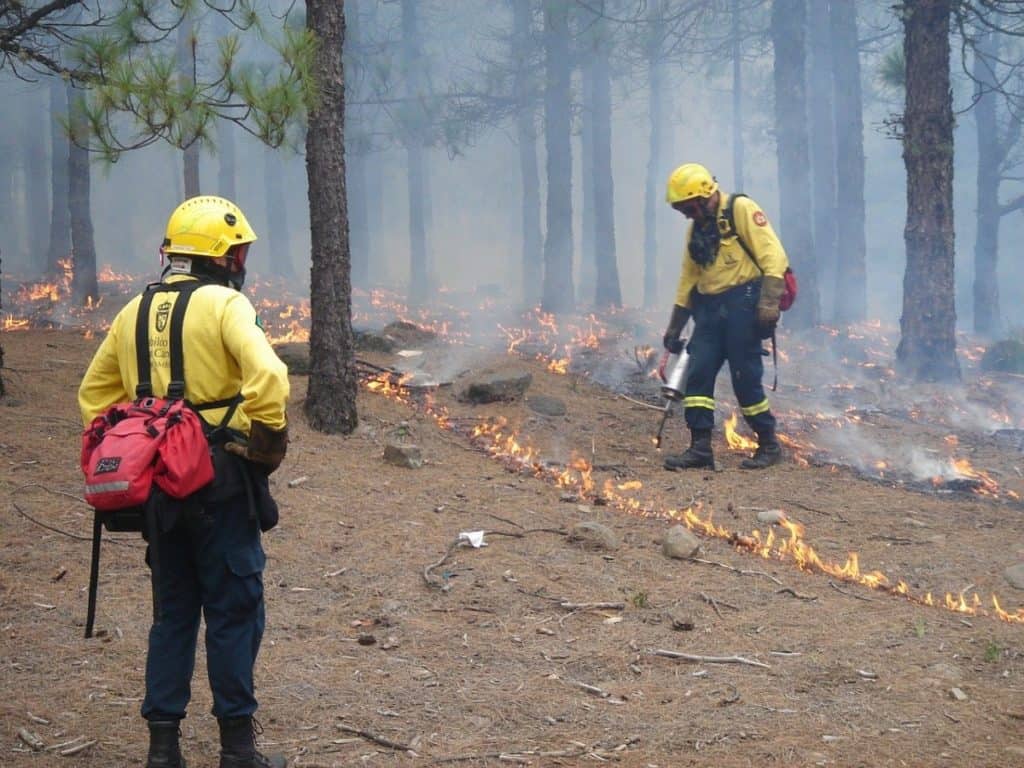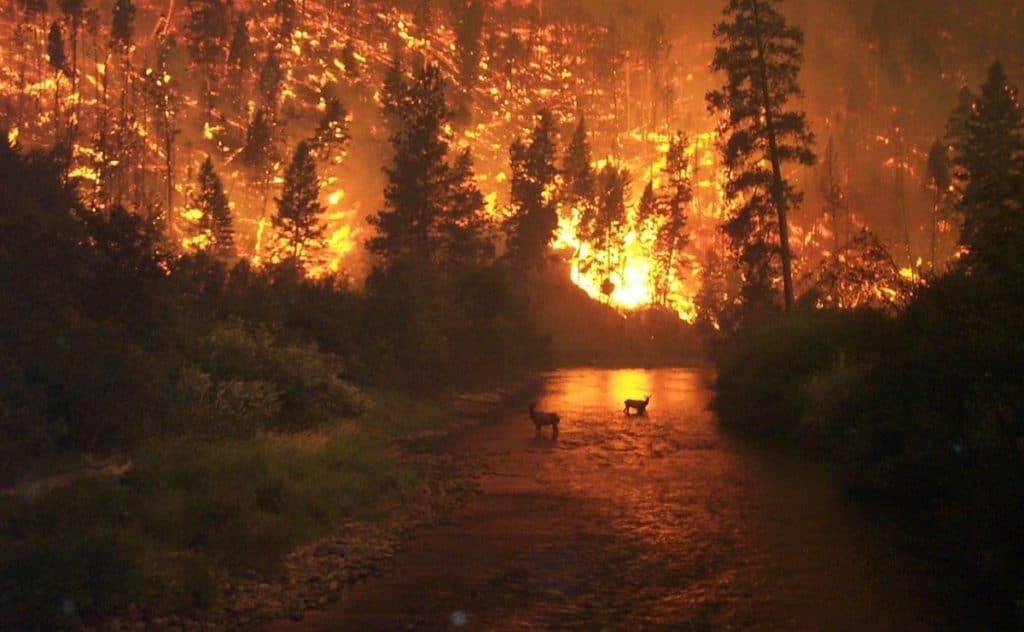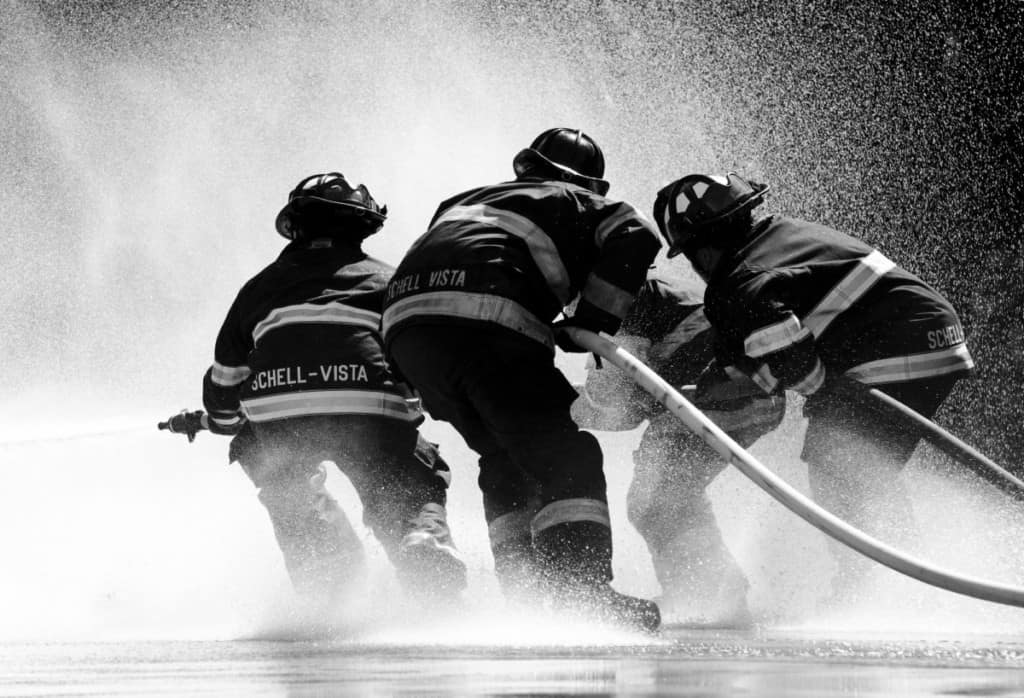Can you really fight fire with fire? Many people wonder if this is possible. People also wonder what a backfire is and why firefighters set them? And even what is a controlled or prescribed burn? Let’s find out.
Firefighters set backfires to stop the spread or change the direction of a wildfire. This is done by burning the fuel (grass, brush, trees, etc.) in front of a wildfire so it has nothing to burn when it reaches that point. Firefighters use a variety of tools to accomplish this.
Backfiring is a powerful, but potentially dangerous tactic. Below we will learn all about what backfiring is, how and why firefighters use this technique, and what tools firefighters use. In order to understand how backfiring works, we will also look into some basic fire science and the fire triangle.
If you are interested in seeing my favorite firefighter boots, check them out here. They are a little pricey, but more than worth the cost.
Your # 1 priority is keeping your family safe. As a firefighter, I recommend everyone has updated smoke detectors that don’t require battery changes, like these ones from Kidde, a fire extinguisher, like this one from Amerex, and a fire escape ladder if you have bedrooms above the first floor, I recommend this one from Hausse.
Also read: Why Do Firefighters Cut Holes In Roofs?
The Fire Triangle: How Fire Works
In order to understand how backfiring works, it helps to first have a good grasp on the science of what makes fire and how it burns. Don’t worry, we won’t get too technical.
Fire needs three things to burn (actually 4, but we will talk about that in a minute). These three things are oxygen, heat, and fuel. These make up the three sides of the fire triangle. (the fourth is a chemical chain reaction and makes up the fourth side of the more advanced fire tetrahedron).
For a fire to start and to continue burning, it needs all three of these elements. If any of these elements are removed from the fire, it will go out.
This is the basis for all firefighting efforts. Depending on the type of fire, how big it is, risk factors, terrain, intensity, weather, resources, and a bunch of other factors, firefighters decide which side of the fire triangle to target and extinguish the fire.
For example, when you put a lid over a pot on the stove that is on fire, you are cutting off the supply of oxygen to the fire and once the fires uses up the oxygen in the pot, it will go out.
Or when water is sprayed on a camp fire, it lowers the temperature until it goes out. This is attacking the heat side.
And finally, when firefighters “cut a line or firebreak” on a wildland fire (forest fire), they are removing all the fuel in the path of the fire so that once it reaches the line, it has nothing to burn and goes out.
Note: This is a simplified version of the science of fire and firefighting, but it is a good basic understanding of what is happening.
Also read: What Is A (1, 2, 3, 4, 5) Alarm Fire? Firefighter Answers
What is Backfiring?

Wildland fires are very different than structure fires and they require different tactics and strategies to handle and extinguish. Much of the firefighting efforts on wildfires are more defensive than offensive.
Backfiring is a tactic where firefighters intentionally set a fire along a fireline’s inner edge, in order to consume the fuel in the path of a wildfire or to change the direction it is traveling.
Like we talked about above with the fire triangle, this method is attacking the fuel side of the fire triangle. If we burn all the fuel before the fire gets to it, the fire will go out or spread in a different direction. This can be used to control the fire’s path and protect certain high-risk areas.
This is can be a very dangerous operation if not done properly. It has to be carefully coordinated and planned. Imagine if a fire was set and the winds quickly change and now the fire is moving in a different direction than was planned? This could lead to the loss of more homes and people or even the deaths of firefighters.
This process is conducted only by highly trained firefighters and in co-ordination with those in charge. Firefighters can use propane torches, fusees (like a road flare), or drip torches to start these fires.
Why Do Firefighters Set Backfires?
So, why do firefighters set backfires? The exact scenarios that warrant using the backfiring technique can be complex as there are a ton of factors that can affect when is the right time to do it.
Basically, firefighters set backfires to stop a wildfire in its tracks. Firefighters use different methods to remove fuel in front of a fire to control and extinguish the fire, backfiring is one of those methods.
You might ask if backfiring is so dangerous and has so many risks, why don’t firefighters just use other methods like cutting line by hand to stop the fire. The answer is, they do, but there are some times where the risk is worth the benefit.
To illustrate, imagine there is a large, fast-moving wildfire coming towards a town. This fire is spreading rapidly because of the strong winds driving it. There is a road between the fire and the town that is two lanes wide.
You might think that the fire would stop at the road, as it’s a natural firebreak and the fire would have nothing to burn. In some cases that would be true, but this fire is burning so hot and moving so fast that it will easily “jump” the fireline and continue into the town.
So, to stop the fire from destroying this town, firefighters need to make a much bigger firebreak that the fire won’t be able to spread across. This could be done with hand tools, bulldozers, or fire retardant dropped from an air tanker, but those resources may be too slow or unavailable at this time.
Maybe in this scenario, firefighters can set a backfire starting at the road and spreading towards the fire. As the backfire eats up the fuel, it creates more and more space that is already burned (called “the black”), so the wildfire has nothing to burn when they meet. This can create a much larger firebreak that can actually stop the fire from making it into the town.
In this case, protecting the town and its residents is worth the risk.
Here is a video of firefighters setting backfires in California:
What is a Firebreak?
A firebreak or fuel break is an area of reduced fuel load to reduce the intensity, change directions or extinguish a fire. This is using the fuel side of the fire triangle to manage a fire.
This firebreak can be natural or man-made and it can take on many different forms, like:
- Road or highway
- River, lake, ocean
- Canyon
- Loggin road
- Hiking trail
- Dozer line (bulldozer)
- Handline (cut with hand tools)
- Fire retardant drop
Firefighter use naturally occurring firebreaks along with those made by firefighters to control and extinguish fires.
What is a Controlled or Prescribed Burn?

A controlled burn or prescribed burn is similar to a backburn. The goal is to burn fuel to create a firebreak or defensible space. The major difference is that while a backfire is used on an active fire to prevent its spread, a controlled burn is used preventatively before any fire starts.
Outside of fire control, controlled burns are also used to improve wildlife habitat, reduce insect populations, destroy invasive plants and to rejuvenate. Certain plants actually need the cones to be burned in order to release the seeds to spread and grow new trees.
Can You Actually Fight Fire with Fire?
So, based on all this, can you actually fight fire with fire? Yes, backfiring and controlled burns are techniques where fire is used to burn fuels that could cause large wildfires to spread out of control. Fire is used to fight fire.
Conclusion
Wildland fires are very different from structure fires and they can’t be controlled and fought the same way. Techniques like backfiring can help to control the spread and change the direction of large forest fires. While some of these techniques can be dangerous, there are times when the risks are worth the rewards.
Related Articles
What Do Wildland Firefighters Do In The Off-Season?

